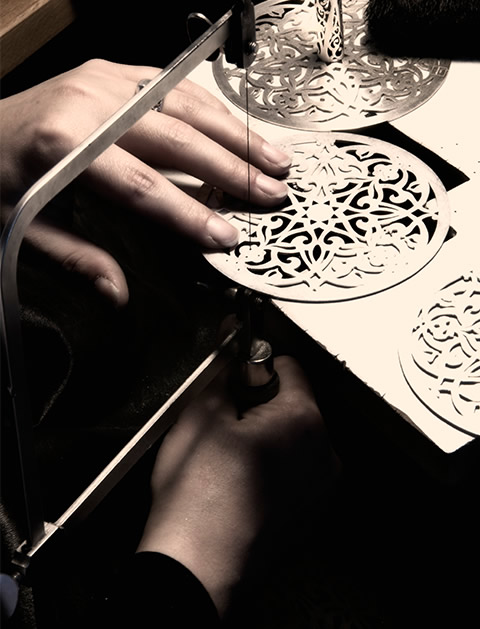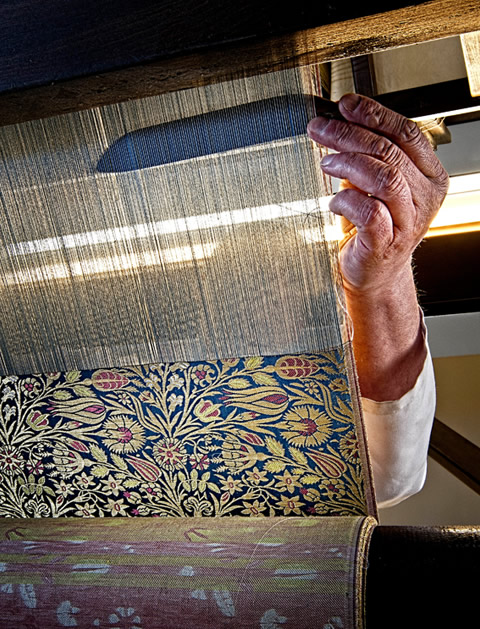KNOW-HOW
JEWELRY AND OBJETS D’ART PRODUCTION
Drawing its inspiration from the traditional handcraft motifs that have left its traces throughout Anatolian history, the traditions from Central Asia to Ottomans that hold a significant place in Anatolian History, architecture and handcrafts, ARMAGGAN Jewelry and Objets d’Art Collection, with its motto “Unique by Design”, is produced with rare, soon-to-fade away hand craftsmanship in limited edition.In the old times, the artisans used to focus solely on ornamentation and stylized the nature which is now the inspiration source to ARMAGGAN Jewelry and Objets d’Art Collection.
Figures such as; Seljuk geometric art, the basis of which is infinity and the order of the universe, The “Rumi” motif which is one of the main elements of Turkish ornamentation craft, representing the unity in diversity, and the symbol of healing, the Bektashi pattern, formed by reoccuring cambers seen in the domes of Seljuk architecture, are used in infitine variations in ARMAGGAN Jewelry and Objets d’Art Collection.

LEATHER PRODUCTION
ARMAGGAN Leather Collections, presents a wide variety of products containing personal accessories with functional details, including the irreplaceable items of the living spaces; produced by examining and applying the history of Anatolian authentic leather working, blended with the modern day production techniques.The collections, designed by ARMAGGAN designers, consist of products made from individually selected hides that are vegetable tanned using locally harvested natural oak, mimosa and sumac bark.
The starting point of ARMAGGAN Leather Collection is not only the traditional attitude in the choice of material and production techniques, but also its rigorous approach, focusing on the needs of the users of these special designs.

TEXTILE PRODUCTION
ARMAGGAN Naturally Dyed Textile Collections are produced in collaboration with Natural Dye Research Design Application Lab (DATU in Turkish), established with the support of Turkish Cultural Foundation. With its; natural dyeing and printings, antibacterial and antimicrobial features, hand sewing techniques, the local and historical point laces of Anatolia, the studies on reconstructing the local silk weaving, the modern interpretations on the designs and special weaving and manufacturing, ARMAGGAN Naturally Dyed Textile Collections are the representatives of our cultural heritage.Chosen from weaving samples that were produced for centuries hence gained their own historical identity, ARMAGGAN “Anatolian hand woven” fabrics are hand manufactured at the Anatolian weaving centers existing since Ottoman and Seljuk times, in cities of Siirt, Hasankeyif, Bayburt, Maraş, Kastamonu, Antakya, Denizli, Manisa with traditional wooden looms with materials carefully produced in ARMAGGAN Textile Research Development and Design departments using the traditional techniques. Mainly from Seljuk times, Ottoman Palace fabrics such as Selçuklu Çatma Kadife, Kemha, Sevai and similar weavings and carpets are analyzed and reproduced in wooden looms, staying ture to historical production techniques and dyeing recipes thus keeping its originality.

DATU - CULTURAL HERITAGE AND NATURAL DYE LAB
DATU-Cultural Heritage Preservation and Natural Dyes Laboratory has four units, Research &Development Laboratory, Ottoman Fabrics, Natural Dyeing & Printing and Dye House.Research and Development Lab
In the Research and Development Lab, replicas that have all the characteristics of Seljuk and Ottoman works are produced and analysis and technical support is provided for the preservation and restoration of the Turkish artworks. Cultural Heritage and Natural Dye Lab aims to introduce the natural dye sources of Turkey, that has the richest plant flora in the world, to revive natural dyeing and to create new employment opportunities in the rural areas for this field.
DATU-Cultural Heritage and Natural Dye Lab, has the widest collection in the World in terms of natural dye sources. The collection involves; dye plants, insects, crustaceans and natural organic laquered pigments. It is estimated that around 300 to 400 types of dye plants are used worldwide. It is known that the number of dye plants in Turkey is around 250. Three of the six dye insects are raised in Turkey. The crustaceans used for dyeing are located in Marmara Sea, Aegean Sea, Mediterrenean Sea and Black Sea.
Thirty different animal and vegetal pigments are produced in the lab. These pigments could also be used as a natural organic ink in such fields as marbling, ornamentation and miniature craft, all of which have a very significant place in Turkish arts and culture. Natural organic pigments were used in paintings, icons and murals in the past. They could also be used fort he renovations and reproductions in such fields.
Reproduction of Ottoman Fabrics
The 16th century Ottoman Palace fabrics, some of the most magnificent fabrics of Turkey’s and world’s leading museums, are reproduced by ARMAGGAN applying the exact same techniques, designs and dyes as those used in the 16th century. Fabrics also features herbal natural antibacterial and natural antimicrobial properties as in the history. Reproduction of Ottoman silk brocades are woven with the original mechanic Jacquard looms.
Natural Printing
Printing inks, which have an important place in textile sector is produced in DATU-Cultural Heritage and Natural Dyes Laboratory. Using special methods to bring together printing and dying technology, the laboratory used natural organic dyestuffs to support the production of new non-toxic, non-carcinogenic textile products with natural antibacterial and antimicrobial properties.
Dye House
Fabrics and fibers are naturally being dyed in dye house, as well as obtaining their antibacterial and antimicrobial properties. All dye plants are annual and biennial with an eco-friendly approach, perennial plants aren’t used not to give harm to the environment.
Non-Destructive Analysis and Microanalysis
Dyestuff and color analyses are performed on archaeologic and historic artifacts, and used in the restoration and preservation of these objects. Through these analysis methods, the laboratory give support to museums in dating and restoring these artifacts. Microanalysis is used to diagnose the dyestuff and the natural organic dye sources by getting a one - three milligram sample from the piece. In addition to dating the artifacts, the analyses help in determining the best method for their restoration and preservation.

